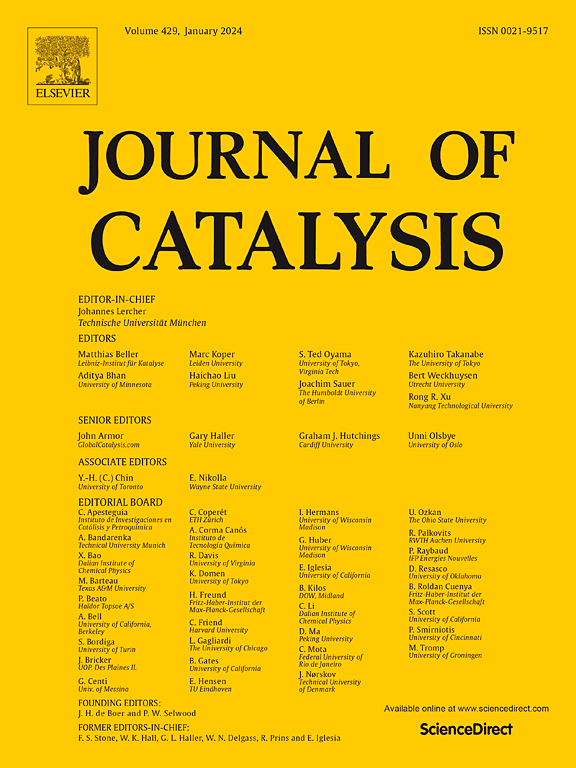Interfacial effect of CoZn-MOFs synergizes with In doping to notably improve efficiency of TaON photoanode photoelectrochemical water splitting
IF 6.5
1区 化学
Q2 CHEMISTRY, PHYSICAL
引用次数: 0
Abstract
For photoelectrochemical hydrogen evolution by complete water splitting, the creation of strong and efficient photoanodes is essential. Herein, the In-TaON/CoZn-MOFs photoanode was developed by doping In ions into TaON, then compounded by CoZn-MOFs. The In-TaON/CoZn-MOFs exhibited remarkably improved performance after cyclic voltammetry (CV) treatment. The current density of In-TaON/CoZn-MOFs-CV was 2.63 mA cm−2 at 1.23 V (vs RHE) under light irradiation (AM 1.5G), which was around 7.3 times that of TaON. After 10 h of running, the current density generated by In-TaON/CoZn-MOFs-CV could still reach about 2 mA cm−2. Compared to the ΔFmax value of 1.77 eV for TaON, the ΔFmax value of In-TaON/CoZn-MOFs with Co2+ as the active site was reduced to 0.38 eV. As a result, the In-TaON/CoZn-MOFs-CV produced a quantity of O2 that was 17.7 times that of TaON.

cozn - mof的界面效应与In掺杂协同作用,显著提高了TaON光阳极的光电化学水分解效率
为了实现完全水分解的光电化学析氢,必须制造出强而高效的光阳极。本文通过在TaON中掺杂In离子,再与CoZn-MOFs复合,制备了In-TaON/CoZn-MOFs光阳极。循环伏安(CV)处理后,In-TaON/CoZn-MOFs的性能显著提高。In-TaON/CoZn-MOFs-CV在光(AM 1.5G)照射下,电流密度为1.23 V (vs RHE),电流密度为2.63 mA cm−2,约为TaON的7.3倍。运行10 h后,In-TaON/CoZn-MOFs-CV产生的电流密度仍可达到2 mA cm−2左右。与TaON的ΔFmax值1.77 eV相比,以Co2+为活性位点的In-TaON/CoZn-MOFs的ΔFmax值降低到0.38 eV。结果表明,In-TaON/CoZn-MOFs-CV产生的O2量是TaON的17.7倍。
本文章由计算机程序翻译,如有差异,请以英文原文为准。
求助全文
约1分钟内获得全文
求助全文
来源期刊

Journal of Catalysis
工程技术-工程:化工
CiteScore
12.30
自引率
5.50%
发文量
447
审稿时长
31 days
期刊介绍:
The Journal of Catalysis publishes scholarly articles on both heterogeneous and homogeneous catalysis, covering a wide range of chemical transformations. These include various types of catalysis, such as those mediated by photons, plasmons, and electrons. The focus of the studies is to understand the relationship between catalytic function and the underlying chemical properties of surfaces and metal complexes.
The articles in the journal offer innovative concepts and explore the synthesis and kinetics of inorganic solids and homogeneous complexes. Furthermore, they discuss spectroscopic techniques for characterizing catalysts, investigate the interaction of probes and reacting species with catalysts, and employ theoretical methods.
The research presented in the journal should have direct relevance to the field of catalytic processes, addressing either fundamental aspects or applications of catalysis.
 求助内容:
求助内容: 应助结果提醒方式:
应助结果提醒方式:


